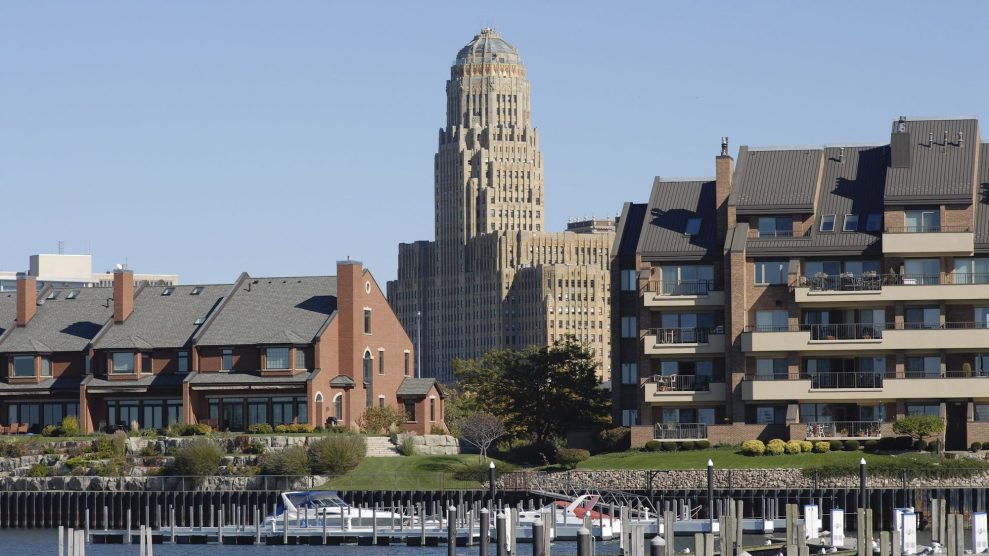
Carlos Moreno/High Country News
This story was originally published by High Country News and is reproduced here as part of the Climate Desk collaboration.
John King had lived in Santa Cruz, California, for 20 years when her below-market-rate lease ended during the Covid-19 pandemic and her landlord took the home off the rental market. Between the effects of tech-related gentrification, the pandemic, and the CZU Lightning Complex fires, King couldn’t find housing. Eventually, two friends in the beach town of Ensenada, Baja California, suggested that she come to stay with them. They helped her find and rent a small guesthouse decorated with Italian tile. “I never anticipated being as happy as I am here,” she said.
Not long after, Elizabeth Bonilla, originally from the state of Sonsonate, El Salvador, also arrived in Ensenada. Bonilla had to grow up fast: She took over her family’s household duties when she was 8, after her mother was diagnosed with a life-threatening kidney illness at a time when heat- and pesticide-related chronic kidney disease was reaching epidemic proportions in low-lying parts of El Salvador. By the time she turned 14, she moved to a small city nearby to begin working. Then, after gangs killed two of her cousins, she fled her home country. Bonilla spent six years in Tapachula, Chiapas, the largest city on Mexico’s southern border, and obtained Mexican residency. She moved to Ensenada after an acquaintance found her a job, leaving her two children and her mother behind in Chiapas. “My whole life has been a long battle for survival,” she wrote to me in Spanish over Facebook Messenger, where we first connected.
King and Bonilla’s experiences speak to two different migrations converging in Baja California, Mexico: US citizens seeking coastal housing at a fraction of US prices, and refugees fleeing Mexico, Central America, and beyond. Climate is a factor in both. Though it’s most visible after natural disasters like hurricanes and wildfires, climate migration encompasses a wide spectrum of experiences — from displacement to wanting a better life, to seeking a place with a preferable climate or more amenities. In every case, however, economic inequality, sometimes exacerbated by climate change, helps shape the migrant’s path.
Of Mexico’s 32 states, Baja California—the state that spans the northern half of the peninsula of the same name—has the fourth-highest immigration rate, according to the country’s 2020 census. Over 85 percent of its documented immigrants are from the United States, according to an interview with Mexico’s National Institute of Statistics and Geography that appeared in the newspaper El Vigía. Most live just a short drive from the border, in coastal communities like Ensenada and Rosarito.
Even so, greater Tijuana’s reputation as a city of migrants didn’t come from southward migration from the US, but rather from internal migration from Mexico. Still, that migration has long connections to dynamics in the US; the city began to grow rapidly during the 1920s and ’30s due to Prohibition-era tourism and deportations of Mexican workers from the US. It continued when US assembly plants began opening in the 1970s and accelerated after NAFTA went into effect in 1994.
In recent years, changing US border policies have left thousands of migrants from Central America and beyond stranded indefinitely here. The “Migrant Protection Protocols,” for example, require some asylum-seekers to remain in Mexico while waiting for hearings, while Title 42, which recently sunset, allowed border officials to deny most asylum claims. Some of those migrants shelter in camps; others stay with acquaintances or find temporary housing on their own. Many, like the generations who preceded them, stay and build a new life.
Increasingly, climate change is a factor in these converging migration flows. King left California for a variety of reasons—economic, political, and climatic. “It was economic, and there were the CZU (Lightning Complex) fires…and then there was a homicide right down the street from me,” she explained in a WhatsApp voice call. Gun violence also made her feel increasingly unsafe in the US: “You could go to school and die, or you could go to Walmart and die.”
Ensenada’s familiar coastal climate appealed to King. “I feel like I found the Mexican Santa Cruz,” she said. “It’s a humble little town on the water; it’s not the desert, it has a mild climate, very temperate.” Climate migration is often a form of amenity migration for US citizens like King, with beach access and pleasant weather figuring alongside housing costs. When King was priced out of California, Baja California offered something similar—more affordably.
Though Bonilla calls herself “a fanatic for the sea,” she’s only been able to visit the beach twice since moving to Ensenada. We spoke over the phone during one of her 36-hour shifts as a security guard at a shipping container yard. “The long hours don’t leave you almost any time to do anything else, and what they pay is barely enough for the high rents.”
Like King, Bonilla said she decided to relocate because of a mixture of factors. She wanted to create some distance from her past and to be able to support her family. The threat of gang violence also played a role. Though she doesn’t consider herself a climate migrant per se, climate change does figure in. As she recalls, “everything started” with her mother’s illness. “My mom was near death, and they removed one of her kidneys,” she said.
During the 1990s, kidney disease became a major public health issue in sugar cane-growing regions of Central America, including Bonilla’s coastal home state. Researchers puzzled over its cause for many years. Their original hypothesis—pesticide exposure— didn’t hold up because it was much less common in mountainous regions than it was in sea-level states, though similar chemicals are used in both. Eventually, they determined that the high rates were linked to a variety of factors, including dehydration and extreme heat as well as pesticide exposure.
The way that kidney disease lurks in the background of Bonilla’s experience illustrates a complicated aspect of climate migration that lawyers and policymakers are grappling with: Though the factors that push people to migrate may not always seem directly climate-related, they are often exacerbated by climate change. “People don’t always conceptualize their experience of displacement in terms of climate change,” said Ama Francis, climate displacement project strategist at the International Refugee Assistance Project (IRAP), “even if there are climate-related reasons for their displacement.”
But existing asylum systems do not recognize climate displacement; their frameworks are restricted to persecution because of race, religion, nationality, political opinions, or membership in a particular social group. That makes it hard for those who do see themselves as climate migrants. “The law just hasn’t caught up to the reality of the climate crisis,” Francis said.
Climate change and violence are also interconnected: Both in Central America and the US, researchers have linked rising temperatures and climate instability to increased gang and gun violence.
Precisely because climate is so intertwined with other factors, IRAP does not advocate for climate-specific asylum pathways. “People are experiencing a number of elements of structural injustice,” Francis said. “We’re advocating for more regular migration pathways for people moving in a changing climate, rather than for just climate-displaced people.”
While Ensenada’s temperate climate currently offers a reprieve from wildfires and extreme heat, Baja California isn’t immune to climate risks. The recent building boom has exacerbated its existing vulnerabilities, including a water shortage; the vast majority of Tijuana’s water comes from the already over-drafted Colorado River. At the same time, flooding and landslides due to limited urban drainage infrastructure and the removal of hillsides during construction are becoming a problem. Meanwhile, the coastal areas are vulnerable to sea-level rise and hurricanes. In the last few years, Baja California’s coastal highways have closed multiple times due to flooding, landslides, and wildfires.
While the impacts of climate change will become more intense over time, neither King nor Bonilla knows how long she will end up staying in Ensenada. King plans to remain here for three to five years, long enough to become proficient in Spanish. Bonilla wants only safety and stability—wherever that may be—and to save money for a home and her children’s education.
She longs to be with them in Tapachula. “Sometimes (on the phone) my son starts crying because he wants me to take him to school, to take him to some park,” she said. “It’s depressing. You want to have your family, and you can’t have it all.”












